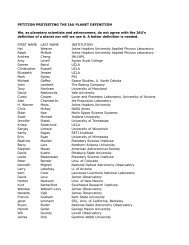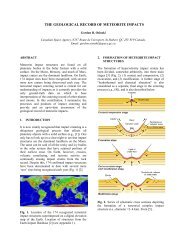Instrument calibration of the Hayabusa near-infrared spectrometer
Instrument calibration of the Hayabusa near-infrared spectrometer
Instrument calibration of the Hayabusa near-infrared spectrometer
You also want an ePaper? Increase the reach of your titles
YUMPU automatically turns print PDFs into web optimized ePapers that Google loves.
instruments slightly. Coalignment between <strong>the</strong> instruments was re-measured in flight andduring <strong>the</strong> asteroid rendezvous.5. In-flight CalibrationAfter launch, <strong>the</strong> NIRS performed a comprehensive series <strong>of</strong> in-flight tests to validateand supplement ground <strong>calibration</strong> data, and to characterize instrument stability, pointing, andco-alignment with o<strong>the</strong>r instruments under flight conditions. The in-flight observations <strong>of</strong>astronomical targets took place during <strong>the</strong> cruise phase before <strong>the</strong> arriving at Itokawa, withNIRS obtaining spatially resolved spectra <strong>of</strong> <strong>the</strong> Earth and Moon, and disk-integrated spectra<strong>of</strong> <strong>the</strong> Mars, Jupiter, and Saturn, including three bright stars.5.1 Long-term StabilityThe periodic onboard <strong>calibration</strong>-target observations in space assessed <strong>the</strong> long-termstability <strong>of</strong> radiometric and spectral characteristics. Figure 7 shows <strong>the</strong> results for <strong>the</strong> NIRS<strong>calibration</strong>-target observations at a constant detector temperature from after launch to <strong>the</strong>rendezvous, including a <strong>the</strong>rmal vacuum test on ground. Figure 7a presents time series plots<strong>of</strong> relative responses for <strong>the</strong> selected NIRS channels normalized by <strong>the</strong> values obtained onMay 16, 2003. Figure 7b in turn presents time series plots <strong>of</strong> <strong>the</strong> NIRS channels peaked in <strong>the</strong>LED spectra. The onboard calibrated LED generates a narrow spectrum centered at <strong>the</strong>specific wavelength <strong>of</strong> ~1.8 μ m. Under a constant temperature condition, its peakwavelength does not shift beyond <strong>the</strong> NIRS spectral resolution.Without short-term general increases as in Earth swingby and <strong>the</strong> arrival, <strong>the</strong> plotsshows <strong>the</strong> gradual changes in NIRS channel responses up to ± 3%. The reason for thisbehavior is probably related to spectral alignment <strong>of</strong> <strong>the</strong> detector. Using <strong>the</strong> data <strong>of</strong> detectorwavelength drift, we found that displacement <strong>of</strong> detector channels can generate such changesin <strong>the</strong> detector responses. The general high responsivity as seen in Earth swingby may beoccurred by <strong>the</strong> lamp brightening due to <strong>the</strong> NIRS continuous operation. The rest <strong>of</strong> <strong>the</strong>overall time series corresponds to a gradual decay <strong>of</strong> <strong>the</strong> instrument primarily due to solar andcosmic ray radiation damage to <strong>the</strong> detectors and electronics. In addition, a general loss <strong>of</strong>3-4% <strong>of</strong> NIRS response in <strong>the</strong> detector resulted from <strong>the</strong> launch.The slight changes in instrument sensitivity over two years <strong>of</strong> in-flight operations werefound, but <strong>the</strong> radiometric response had been highly stable on time scale <strong>of</strong> a few months. Theli<strong>near</strong>ities <strong>of</strong> NIRS detector response also were verified from <strong>the</strong> various exposure-timeframes on <strong>the</strong> <strong>calibration</strong>-target observation. Thus, we found that differences in instrument9



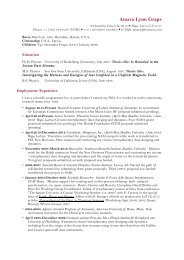
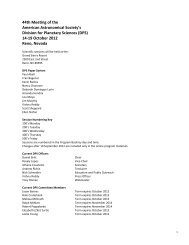
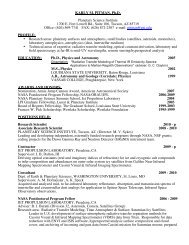
![Large-Aperture [OI] 6300 Ã
Photometry of Comet Hale-Bopp ...](https://img.yumpu.com/37144207/1/190x245/large-aperture-oi-6300-a-photometry-of-comet-hale-bopp-.jpg?quality=85)
